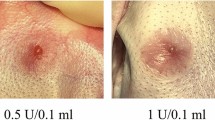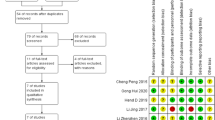Abstract
Background
Hypertrophic scar (HS) is a refractory skin disease caused by major physical damage or other inflammation. Some reports found that botulinum toxin type A (BTXA) could be an alternative treatment of the HS. Therefore, the authors studied the effects of BTXA on the treatment of HS and the dose response of BTXA.
Methods
Hypertrophic scars were harvested from the ears of 18 young adult New Zealand big-eared rabbits and treated with BTXA or triamcinolone acetonide (TAC) in vivo experiment. The hypertrophic index (HI) was measured by histological examination. Collagen fibrils were checked by sirius red straining, and the cell nucleuses of fibroblasts were checked by Ki67.
Results
The HI of hypertrophic scars with BTXA treatment was lower than that with phosphate-buffered saline treatment (P < 0.05). Compared with the TAC treatment group, the efficacy of treatment with the middle dose of BTXA (1.0, 1.5 IU) had no significant difference, as shown by sirius red staining and immunohistochemistry Ki67.
Conclusion
These results demonstrated that BTXA effectively improved the appearance of hypertrophic scars and inhibited the formation of collagen fibrils and fibroblasts in vivo. Treatment with the middle dose of BTXA achieved similar efficacy as TAC treatment, indicating that BTXA might be useful for inhibiting hypertrophic scars and worth investigating further.
No Level Assigned
This journal requires that authors assign a level of evidence to each submission to which Evidence-Based Medicine rankings are applicable. This excludes Review Articles, Book Reviews, and manuscripts that concern Basic Science, Animal Studies, Cadaver Studies, and Experimental Studies. For a full description of these Evidence-Based Medicine ratings, please refer to the Table of Contents or the online Instructions to Authors www.springer.com/00266.





Similar content being viewed by others
References
Gassner HG, Sherris DA, Otley CC (2000) Treatment of facial wounds with botulinum toxin A improves cosmetic outcome in primates. Plast Reconstr Surg 105(6):1948–1953
Ahuja RB, Chatterjee P (2014) Comparative efficacy of intralesional verapamil hydrochloride and triamcinolone acetonide in hypertrophic scars and keloids. Burns 40(4):583–588
Helm CJ, Holland GN (1995) The effects of posterior subtenon injection of triamcinolone acetonide in patients with intermediate uveitis. Am J Ophthalmol 120(1):55–64
Massin P, Audren F, Haouchine B, Erginay A, Bergmann J-F, Benosman R et al (2004) Intravitreal triamcinolone acetonide for diabetic diffuse macular edema: preliminary results of a prospective controlled trial. Ophthalmology 111(2):218–224
Xiao Z, Qu G (2012) Effects of botulinum toxin type a on collagen deposition in hypertrophic scars. Molecules 17(2):2169–2177
Tracy LE, Minasian RA, Caterson E (2016) Extracellular matrix and dermal fibroblast function in the healing wound. Adv Wound Care 5(3):119–136
Shamel M, Al Ankily MM, Bakr MM (2016) Epidermal growth factor (EGF) and botulinum toxin (BTX); can paralysis be a bless? J Res Med Dent Sci 4(1):1–9
Haubner F, Ohmann E, Müller-Vogt U, Kummer P, Strutz J, Gassner HG (2012) Effects of botulinum toxin A on cytokine synthesis in a cell culture model of cutaneous scarring. Arch Facial Plast Surg 14(2):122–126
Haubner F, Leyh M, Ohmann E, Sadick H, Gassner HG (2014) Effects of botulinum toxin A on patient-specific keloid fibroblasts in vitro. Laryngoscope 124(6):1344–1351
Morris DE, Wu L, Zhao L, Bolton L, Roth S, Ladin D et al (1997) Acute and chronic animal models for excessive dermal scarring: quantitative studies. Plast Reconstr Surg 100(3):674–681
Lawrence WT (1991) In search of the optimal treatment of keloids: report of a series and a review of the literature. Ann Plast Surg 27(2):164–178
Wang H, Chen Z, Li X-J, Ma L, Tang Y-L (2015) Anti-inflammatory cytokine TSG-6 inhibits hypertrophic scar formation in a rabbit ear model. Eur J Pharmacol 751:42–49
Tuan T-L, Nichter LS (1998) The molecular basis of keloid and hypertrophic scar formation. Mol Med Today 4(1):19–24
Gabbiani G (1996) The cellular derivation and the life span of the myofibroblast. Pathol Res Pract 192(7):708–711
Koc E, Arca E, Surucu B, Kurumlu Z (2008) An open, randomized, controlled, comparative study of the combined effect of intralesional triamcinolone acetonide and onion extract gel and intralesional triamcinolone acetonide alone in the treatment of hypertrophic scars and keloids. Dermatol Surg 34(11):1507–1514
Robert A (2001) Botox injection. Med J 12(2):18
Xiao Z, Zhang F, Cui Z (2009) Treatment of hypertrophic scars with intralesional botulinum toxin type A injections: a preliminary report. Aesthetic Plast Surg 33(3):409–412
Xiao Z, Zhang M, Liu Y, Ren L (2011) Botulinum toxin type a inhibits connective tissue growth factor expression in fibroblasts derived from hypertrophic scar. Aesthetic Plast Surg 35(5):802–807
Atkinson J-AM, McKenna KT, Barnett AG, McGrath DJ, Rudd M (2005) A randomized, controlled trial to determine the efficacy of paper tape in preventing hypertrophic scar formation in surgical incisions that traverse Langer’s skin tension lines. Plast Reconstr Surg 116(6):1648–1656
Zhibo X, Miaobo Z (2008) Botulinum toxin type A affects cell cycle distribution of fibroblasts derived from hypertrophic scar. J Plast Reconstr Aesthet Surg 61(9):1128–1129
Moon H, Yong H, Lee A-RC (2012) Optimum scratch assay condition to evaluate connective tissue growth factor expression for anti-scar therapy. Arch Pharm Res 35(2):383–388
Gassner HG, Brissett AE, Otley CC, Boahene DK, Boggust AJ, Weaver AL et al (2012) Botulinum toxin to improve facial wound healing: a prospective, blinded, placebo-controlled study. Mayo Clin Proc 81(8):1023–1028
Sherris DA, Gassner HG (2002) Botulinum toxin to minimize facial scarring. Facial Plast Surg 18(01):035–040
Ahmed K, Oas KH, Mack KJ, Garza I (2010) Experience with botulinum toxin type A in medically intractable pediatric chronic daily headache. Pediatr Neurol 43(5):316–319
Xiao Z, Zhang F, Lin W, Zhang M, Liu Y (2010) Effect of botulinum toxin type a on transforming growth factor β1 in fibroblasts derived from hypertrophic scar: a preliminary report. Aesthetic Plast Surg 34(4):424–427
Xiaoxue W, Xi C, Zhibo X (2014) Effects of botulinum toxin type A on expression of genes in keloid fibroblasts. Aesthetic Surg J 34(1):154–159
Author information
Authors and Affiliations
Corresponding author
Ethics declarations
Conflict of interest
The authors declared that they have no conflicts of interest to this work and that they do not have any commercial or associative interest that represents a conflict of interest in connection with the work submitted.
Appendix
Appendix
Photographs of our model are shown here. The left picture shows the hypertrophic scars just after the surgical operation, and the right shows the hypertrophic scars after 60 days with BTXA treatment.

Rights and permissions
About this article
Cite this article
Liu, Dq., Li, Xj. & Weng, Xj. Effect of BTXA on Inhibiting Hypertrophic Scar Formation in a Rabbit Ear Model. Aesth Plast Surg 41, 721–728 (2017). https://doi.org/10.1007/s00266-017-0803-5
Received:
Accepted:
Published:
Issue Date:
DOI: https://doi.org/10.1007/s00266-017-0803-5




